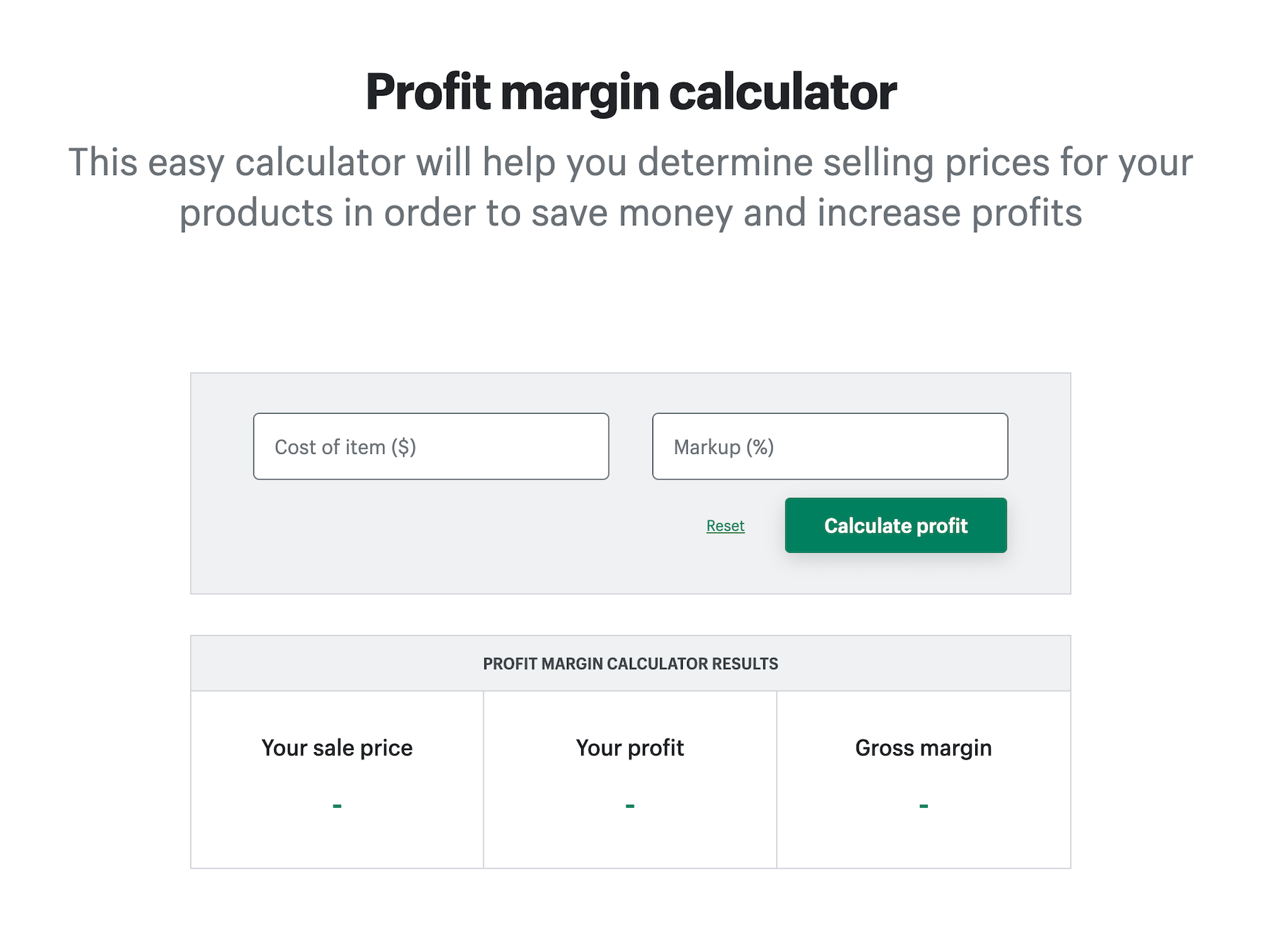
Running an ecommerce business is not without challenges, one of which is making enough money to keep your doors open. Did you know that only 20% of businesses survive in the ecommerce industry? This means 80 out of a 100 businesses are breaking even with their expenses or losing money. This is why it’s critical to track your profit margin so you can see where you stand and take steps to keep the business going.
Start selling online now with Shopify
Start your free trial



What is profit margin?
Profit margin is the percentage of sales revenue a business retains after all costs have been deducted. Simply put, it measures how much you keep of the money you generate from a sale. The higher your profit margin, the better financial health your company attains.
Profit margin exists in several forms, with the following being the most popular:
- Gross profit margin (or gross margin)
- Operating profit margin (or operating margin)
- Net profit margin (or net margin)
Here’s a detailed breakdown of each type.
Gross profit margin
Gross profit margin shows the profit of a company after accounting for costs related to making and selling its product or service.
Calculating gross profit requires you to subtract the cost of goods sold (COGS) from total revenue. Divide the sum into the total revenue and multiply the result by 100 to get the percentage, which represents the gross margin.
Gross profit formula = [Total Revenue – COGS] / Total Revenue (x 100)
Note that COGS refers to direct product costs rather than indirect expenses like rent and office supplies.
Calculating the gross profit can help you determine whether your company is running a profitable operation and if prices need to be changed. If your gross profit margin is low, it could mean that you need to charge more to make selling a specific item worthwhile.
What is the ideal gross profit margin?
The ideal gross margin figure varies from industry to industry. For online retail, it’s around 45.25%, according to the NYU Stern School of Business. To make a higher gross profit, you’ll need to start charging optimal prices for your products.
Shopify’s profit margin calculator can help you determine a profitable selling price for your goods. It’s a user-friendly tool that calculates what price you should charge customers for your merchandise to achieve an optimal profit margin ratio.

Operating profit margin
Operating profit margin shows a company’s profit after accounting for variable costs, i.e., the indirect expenses associated with running your business.
Compared to gross margin, operating margin considers a range of other operating expenses like utilities, rent, payroll and labor costs, advertising, and insurance, just to name a few.
Calculating the operating margin can give you a better insight into your pretax profit and reveal how operating expenses are affecting your company’s profitability.
To calculate operating profit, subtract operating costs from total revenue. Then, divide the sum into the total revenue and multiply the result by 100.
Operating profit formula: [Total Revenue – COGS + Operating Costs] / Total Revenue (x 100)
Net profit margin
Net profit margin shows a company’s profit after deducting all of its expenses, including the cost of goods sold, operating costs, and interest payments and taxes.
Net profit formula: [Total Revenue – Total Costs] / Total Revenue (x 100)
Calculating your net margin can help you gauge the overall success of your business. A high net margin indicates your company is doing a great job of managing its expenses and making sales.
You can also use net profit margin to compare your company’s performance with that of its competitors. However, the businesses should have approximately the same customer base and cost structure for the comparison to make sense.
What is a good profit margin?
A good profit margin for your company depends on your industry, location, and customer base. As a general rule, a 10% net profit margin is deemed good, while a 20% margin is deemed excellent, and a 5% margin is deemed poor. If you want to compare your company’s performance based on gross margin and net margin, check out the average profit margin for your sector.
How to increase profit margin

1. Be willing to lose money on some orders
As an ecommerce business, it’s OK to lose money on some orders if it gives you a chance to know the customer better. Today’s customers are so accustomed to mediocre experiences that when a company goes out of its way to proactively build a relationship, they’re blown away.
So how do you invest in the future of your customer relationships? Here are some ideas:
- If a customer wants to return an extensive item, ship them a replacement as soon as they share tracking information of the return instead of waiting until the product reaches your warehouse.
- When something inexpensive breaks, ship customers a free replacement immediately without making them hassle with the return.
- Is a customer unhappy with an order? Give a partial refund to help compensate them for the unsatisfactory experience.
These strategies will cost a bit more in the short run, but will have an incredible impact as you build a highly vocal and loyal fan base that improves the financial health of your business.
2. Slash operating costs
A quick and effective way to improve profit margin is to reduce operating costs and expenses.
Although these costs vary from business to business, you’ll want to audit the expenses commonly incurred in running a business, including:
- Licenses
- Office space and utilities
- Employee benefits
- Insurance
- Labor costs
- Equipment and maintenance fees
Then look at where you can cut back on operating expenses and where technology can help. For instance, if you provide 24/7 customer service via Facebook and have three employees working eight-hour shifts each, you could reduce operating expenses by using a chatbot during non-work hours.

3. Raise your prices
Many business owners fear that if they raise their prices, customers will abandon them. But if you’re providing a great experience and proactively resolving customer issues, a small increase in price can do miracles for your business.
When pursuing this strategy, consider using creative or psychological tactics. For instance, if you’re selling a product at retail and wholesale, you can leave the retail price as is but increase the wholesale price by $ 5. This way, customers would still get a great deal when they buy wholesale while your company will enjoy a higher profit margin.
4. Increase your average order value
Average order value (AOV) is the average dollar amount a customer spends per purchase in your store. Increasing AOV is a simple way to improve your profit margin ratio.
There are a number of ways you can increase your average order value:
- Offer minimum order incentives. You can get higher margins and increase your AOV by encouraging customers to spend a minimum amount. One way to do this is to offer free shipping on a minimum order amount, which you can set up in Shopify within minutes.
- Upsell or cross-sell complementary items. Rather than suggesting bestsellers in your store, you can recommend products that go well with items in a visitor’s cart. For instance, a mixing bowl for hair dye or shaving cream with razors.
- Create product bundles or packages. Product bundles work great for increasing the perceived value of a customer’s purchase and help provide a better shopping experience. To get people to buy more, create bundles of products that cost less when purchased together versus individually.
5. Build a customer loyalty program
Customer loyalty programs are a proven way to increase profitability in retail and the service industry. Sephora, for instance, has a customer loyalty program with over 17 million members, who account for nearly 80% of the brand’s sales.

Rather than spending money to run new campaigns, you can create a customer loyalty program to increase profit margin quickly.
You can set up a loyalty program where customers earn rewards for each purchase based on a point system. Once they accrue enough points, let them choose how to use them—whether through discounts or gift cards to help offset the initial cost.
Set your business up for success
Tracking the profit margin for your business can help you determine what steps you should take to survive and thrive. While you’re doing this, you must keep the customer experience intact. With these tips for increasing your profit margin, you can build a strong foundation for your business and weather any economic uncertainty in the future.
Profit margin FAQ
Why is profit margin important?
Profit margin is a good yardstick for determining the overall financial health of your business. The higher your profit margin, the more efficient your business is in managing costs and setting prices.
What does an increase in profit margin mean?
A rise in profit margin implies that after deducting costs, your company is earning more money from each client served or product sold.
How can a business increase profits?
- Stop obsessing over per-order profits.
- Reduce operating costs.
- Raise your prices.
- Increase your average order value.
- Create a customer loyalty program.
Start selling online now with Shopify
Start your free trial



Want to learn more?
- How Much Does it Cost to Launch a Dropshipping Store?
- Why Bookkeeping is Essential for Your Online Business
- How Much Money Can You Make With an Ecommerce Store?
- How to Create a Personal Financial Plan As An Entrepreneur